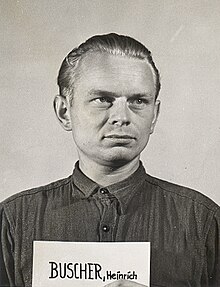Draft:Heinrich Buscher
Heinrich Buscher (SS Member)[edit]
Heinrich Buscher (11 July 1911 in Nordenham – † 9 October 1954 in Westerstede) was a German SS leader and witness at the Nuremberg Trials.

Life and work[edit]
Heinrich Buscher was the son of the architect and mayor Friedrich Buscher and his wife Hilke, née van Dieken.
After graduating from high school in Oldenburg, he studied economics at the University of Marburg. On 1 March 1931, Buscher joined the NSDAP (membership number 468,224)[1] and in the same year joined the SA. He soon embarked on a career as a functionary in the party: on 7 August 1933 he was appointed head of the Gauamtswalterschule Haus Osterberg near Loy. On 20 July 1934, he was appointed Gau Inspector for Training in the Weser-Ems Gau. Subsequently, until May 1936, he served as Gau Training Leader of the Weser-Ems Gau.
On August 12, 1939, Buscher was called up for military service as a lieutenant in the reserve. From 4 January 1940 to 15 July 1940, he served as Legation Counsellor to the Federal Foreign Office's representative at the Army High Command (AOK) 18. He then held the same position at AOK 9 before being placed at the disposal of the German Embassy in Paris in the fall of 1940. There he worked until October 1942 as a clerk for active propaganda in the information office of the embassy.
From 18 October 1942 to 6 July 1943, Buscher served as Gauschulungsleiter of the Gau Weser-Ems of the NSDAP and then, with the official title of Oberbereichleiter, as representative of the Fuehrer's Commissioner for the entire intellectual and ideological education of the NSDAP in the Gau Weser-Ems.
In 1944, Buscher enlisted in the Waffen-SS to fight with the 12th SS Panzer Division Hitlerjugend at the front until the end of the war, ultimately as SS-Obersturmführer. At the end of the war, Buscher was taken prisoner by the Allies. Subsequently, he was interrogated as a witness at the Nuremberg Trials.[2]
In 1949 he founded a textile mail-order business in Oldenburg and also became active as a writer under the pseudonym "Klaas Kunst". Around 1950, the family moved from Oldenburg to Bad Zwischenahn.[3]
His daughter is the author and teacher Hilka Koch, née Buscher, who takes a critical stance on her father's Nazi past and advocates reconciliation between Jews and Germans.[4]
Literature[edit]
- Joachim Lilla (Ed.): The Deputy Gauleiter and the Representation of the Gauleiter of the NSDAP in the "Third Reich". Publisher: Bundesarchiv, Koblenz (= Materials from the Federal Archives. Issue 13). Wirtschaftsverlag NW, Bremerhaven 2003, ISBN 3-86509-020-6, p.9–10 .
References[edit]
- Bundesarchiv R 9361-IX KARTEI/5300621
- List of witnesses at the Nuremberg Trials (PDF; 186 kB).
- Cf. information by and about Hilka Koch, née Buscher, in: Beziehungskrise. Home in uncertain times.(PDF; 86 kB) Radio feature by Rosemarie Bölts. Deutschlandradio Kultur, 28 January 2013, pp. 10–11, accessed 11 January 2020.
- Andreas Berger: A Jewish woman and the daughter of an SS man want to free themselves from hatred. In: braunschweiger-zeitung.de. 15 March 2005, retrieved 2 January 2020.
